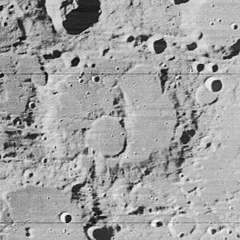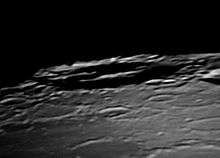Xenophanes (crater)
Xenophanes is a lunar impact crater that is located along the northwestern limb of the Moon. It is nearly attached to Volta, a similar formation to the south-southwest. To the northeast is the smaller crater Cleostratus. Xenophanes is significantly foreshortened when viewed from the Earth, hindering observation.
 Oblique Lunar Orbiter 4 image | |
| Coordinates | 57.5°N 82.0°W |
|---|---|
| Diameter | 125 km |
| Depth | 3.2 km |
| Colongitude | 86° at sunrise |
| Eponym | Xenophanes |
It is a worn and eroded crater with a battered outer rim that is overlaid by several smaller craters. The rim is a circular range of rugged, irregular ground that is notched in places along the inner wall. A chain of small craters lies along the northern and northeastern rim. At the west end, a pair of clefts in the rim nearly join the floor to the surface beyond. To the northeast, Xenophanes A is an impact crater with a sharp rim and a rough interior.
The interior surface is irregular, but sections have been resurfaced by basaltic lava. A pair of flooded crater rims lie along the southern and northeast sections of the interior. The interior is more level and less rough at the eastern end.

Satellite craters
By convention these features are identified on lunar maps by placing the letter on the side of the crater midpoint that is closest to Xenophanes.
| Xenophanes | Latitude | Longitude | Diameter |
|---|---|---|---|
| A | 60.1° N | 84.8° W | 42 km |
| B | 59.4° N | 80.5° W | 15 km |
| C | 59.6° N | 78.7° W | 8 km |
| D | 58.6° N | 77.4° W | 12 km |
| E | 58.1° N | 85.8° W | 12 km |
| F | 56.7° N | 73.2° W | 24 km |
| G | 56.9° N | 75.7° W | 7 km |
| K | 58.7° N | 84.5° W | 13 km |
| L | 54.8° N | 78.6° W | 21 km |
| M | 54.8° N | 79.6° W | 9 km |
References
- Andersson, L. E.; Whitaker, E. A. (1982). NASA Catalogue of Lunar Nomenclature. NASA RP-1097.CS1 maint: ref=harv (link)
- Blue, Jennifer (July 25, 2007). "Gazetteer of Planetary Nomenclature". USGS. Retrieved 2007-08-05.CS1 maint: ref=harv (link)
- Bussey, B.; Spudis, P. (2004). The Clementine Atlas of the Moon. New York: Cambridge University Press. ISBN 978-0-521-81528-4.CS1 maint: ref=harv (link)
- Cocks, Elijah E.; Cocks, Josiah C. (1995). Who's Who on the Moon: A Biographical Dictionary of Lunar Nomenclature. Tudor Publishers. ISBN 978-0-936389-27-1.CS1 maint: ref=harv (link)
- McDowell, Jonathan (July 15, 2007). "Lunar Nomenclature". Jonathan's Space Report. Retrieved 2007-10-24.CS1 maint: ref=harv (link)
- Menzel, D. H.; Minnaert, M.; Levin, B.; Dollfus, A.; Bell, B. (1971). "Report on Lunar Nomenclature by the Working Group of Commission 17 of the IAU". Space Science Reviews. 12 (2): 136–186. Bibcode:1971SSRv...12..136M. doi:10.1007/BF00171763.CS1 maint: ref=harv (link)
- Moore, Patrick (2001). On the Moon. Sterling Publishing Co. ISBN 978-0-304-35469-6.CS1 maint: ref=harv (link)
- Price, Fred W. (1988). The Moon Observer's Handbook. Cambridge University Press. ISBN 978-0-521-33500-3.CS1 maint: ref=harv (link)
- Rükl, Antonín (1990). Atlas of the Moon. Kalmbach Books. ISBN 978-0-913135-17-4.CS1 maint: ref=harv (link)
- Webb, Rev. T. W. (1962). Celestial Objects for Common Telescopes (6th revised ed.). Dover. ISBN 978-0-486-20917-3.CS1 maint: ref=harv (link)
- Whitaker, Ewen A. (1999). Mapping and Naming the Moon. Cambridge University Press. ISBN 978-0-521-62248-6.CS1 maint: ref=harv (link)
- Wlasuk, Peter T. (2000). Observing the Moon. Springer. ISBN 978-1-85233-193-1.CS1 maint: ref=harv (link)